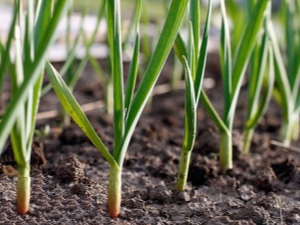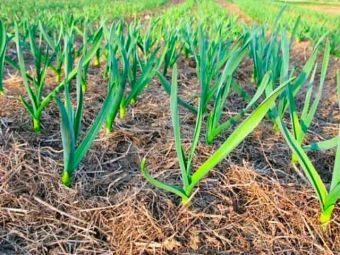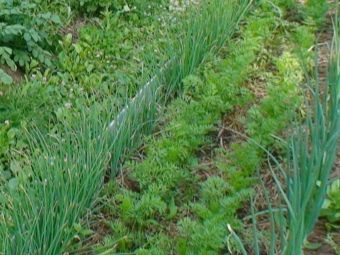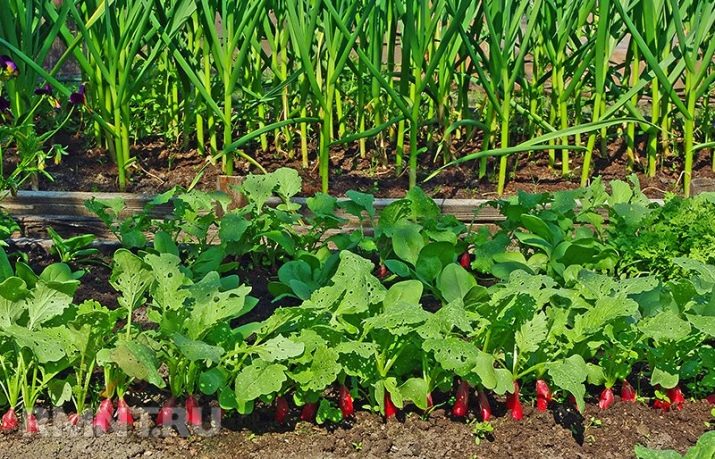What kind of vegetables can I plant next to garlic?

Experienced gardeners are well aware that in order to obtain a rich harvest on a land plot, it is necessary to respect the conditions of crop rotation.Therefore, the change of various crops grown on it is fully justified.
Even the presence of garlic on the site is a biological method of its recovery. A large concentration in all parts of this culture of active substances helps to cope with the spores of fungi, which prevents the development of fungal infections, and also saves from harmful insects and various pathologies. Excessive acidity at the site can be eliminated with the help of ash or lime. Asbestos should not be used for this, although it changes the acidity of the soil. Too exhausted parts of the vegetable garden are saturated with organic dressings.
It is strictly impossible to fertilize garlic with fresh manure, this can lead to the occurrence of soil diseases.
Features of crop rotation
Crop rotation is one of the main methods of gardening. Changing planting sites minimizes the risk of pests and diseases. Because of this, the plants absorb nutrients from the soil with the greatest benefit.
In such a "cycle" of various plants, garlic was not left out, and it was easy to get a harvest, you just need to know what can be planted before and after.
Compliance with the rules of crop rotation plays a huge role in any gardening. Gardeners with high experience thoroughly calculate where and for what purpose the beds will be located, and what will be planted on them. This takes into account what grew at this place last year.
Compatibility with other cultures is very important: when the combination is suitable, the neighboring cultures will not suffer and will delight in the fall with their harvest. Incompatible with garlic culture, it is very likely that they will be able to adversely affect its growth and healthy state.
On the contrary, the cultures, which are a suitable neighborhood in the garden, complement each other, help to get rid of the invasion of pests and to stand against diseases. This ratio of plants makes it possible to get a fully justified return from any corner of the site.
Proper planning of crop shifts on the land plot solves many problems.
- Keeps a steady increase in the benefits of the soil, which ensures a good harvest without the use of artificial additives. And it also limits the growth of weeds, resulting in improved plant and soil health.
- The development of microorganisms that positively affect the fertility of the soil, after planting secondary crops. Especially when garlic was previously growing in that place.
Compatible cultures
Many people ask: what can garlic be planted with, and whether there are plants that do not harm this spice. Garlic in the garden plays the role of a suburban destroyer of harmful fungi, and also prevents the growth and development of pathogenic bacteria. Such properties of this culture affect the many neighboring plants, contributing to their development.
For example, joint harvested garlic crops help potatoes to get less pain from phytophthora. If you plant garlic between strawberry bushes, you can get rid of most of the insects harmful to it.
In the case when the bed with garlic is located nearby with lettuce and carrots, it can scare leaf bullets and carrot flies, which often harm carrots.
Green will be an excellent companion of garlic culture. You can plant cloves between parsley and any kind of salads. It also favorably affects vegetables, especially cucumbers and tomatoes. Garlic will become a natural protector for berries and flowers. Especially this neighborhood will contribute well to tulips, gladioli, roses, raspberries and currants. Together or near garlic, beets or peppers will grow well.
A strong and fragrant harvest of garlic can be, if it is planted after pumpkin, potatoes, cabbage. It should be noted that the culture itself will be an excellent predecessor for almost any plant. Practically, garlic does not need neighboring plants, but it is often beneficial, thanks to the pesticide qualities that are beneficial, scaring away:
- Colorado beetles;
- aphids and other pests.
Sometimes gardeners instead of planting garlic use a method of spraying growing crops with garlic infusion.
Unsuitable neighbors
It would be wrong to randomly choose a place to plant garlic. Be sure to remember that grew in this garden. Any plant growing at the planting site affects the development of garlic.
It is undesirable to plant the garlic in the place where it was previously planted or the onions grew. It is preferable to give this place to grains and melons. Such plants saturate the earth with useful microelements, legumes and fodder herbs have the same property - they supplement the soil with minerals, which makes it possible to obtain a rich harvest.
Garlic, radishes, turnips and carrots will be unsuitable crops for garlic. The preceding mint, basil, coriander and celery on the garden, on which there is a desire to plant garlic, is also not recommended. Salad also cannot become a forerunner for garlic, despite the fact that it grows well near it.
Nearby beds of garlic have a bad effect on fruitfulness:
- beans;
- soy;
- peanuts;
- beans;
- lentils;
- peas.
In the garden area it is better to plant them away from the place of cultivation of garlic. It is strictly impossible to grow garlic culture after any bulbous plants. They are afraid of the same pests and require the same nutrients. Therefore, a year after collecting garlic in this garden, it is better not to plant any types of onions.
Radishes are also not worth sowing in the place where it is planned to plant garlic in the future. It can not be grown in the shade of tall plants. We can only allow light partial shade. Garlic is prevented by weed roots, especially from wheatgrass, if grown earlier in this place.
Eventually:
- do not plant one plant nearby;
- after the annual interval, do not plant similar crops at the same place;
- do not alternate plants that require the same substances from the soil;
- not allow shade from the highest neighbors;
- take into account the depth of the roots and their competitors.
Tips
To get a good harvest, you should use tips from experienced gardeners when growing garlic.
- Often do not plant in one place. Garlic prefers, when he often change the place of landing. There is even an opinion that it is necessary to plant in the place where he grew up no earlier than five years later. However, not all gardeners can afford it, so the bed for planting is better to change at least in a period of two, preferably three years. And also the garlic doesn’t survive well on the spot where the onion had recently grown. It is not recommended to plant it after the plants of the nightshade family in order to avoid infection with fusarium. Planting after melons and legumes will be a good option, especially winter garlic grows beautifully. He also loves to “live next door” with strawberries.
- Do not use manure as bait. Before planting garlic soil should not be fertilized with manure. It is more suitable fertile, and at the same time neutral land. Manure, on the other hand, gives the soil acidity and greatly enriches with nitrogen. The best feeding will be peat, it must be dug up with soil on a blade bayonet. And add about thirty grams of superphosphate and twenty grams of fertilizer containing potassium, and that is all per square meter.
Before planting garlic, you can fertilize ammonium nitrate, about ten grams in the same area.
- Select the soil. In principle, winter garlic loves light soils with a predominance of sand, with a fairly high passage of air and moisture, while it does not like to be in the shade and damp. Therefore, it is necessary to choose a plot that is at the highest level of the ground, the soil is less heavy there, and less damp.But it is necessary to take into account the density of the earth - if it is too dense, it can push garlic out in winter and it will freeze out. However, the very soft soil can harm, in this case, the earth can drag the garlic deep into, and then the harvest will turn out with small heads.
- Soak before planting. In order to avoid garlic, it is necessary to dry the cloves well beforehand, and then the garlic can be placed in a weak manganese solution for no more than three hours. For better effectiveness, it is recommended to supplement a strong mixture of table salt, about a little more than a dessert spoon per liter of water, but for a very short time - no more than three minutes. Or at the same time, put in a solution of copper sulfate in the proportion of one teaspoon per two liters of water.
- Be careful. Do not forget about the "maternal" part, you need to free the teeth from it, otherwise it will retard the growth. Planting garlic should be made at a distance of about fifteen centimeters. When planting in rows, the distance between them should be more than twenty centimeters. You shouldn’t push the teeth into your hands, it can damage the growth of the roots. It is better to make a hole deep, commensurate with the length of the middle finger and put a clove of garlic in it. But the depth should not exceed four centimeters.
Despite all this, some gardeners recommend planting garlic for a deeper distance, especially when you are not late in planting before cooling. Such a deep planting will save the teeth of garlic from frost, but can affect fertility.
- Do not forget about the mulch. When the soil before planting is very dry, you need to water it. But only during the landing period. After landing, do not forget to mulch the landing site with peat, humus or sawdust for no more than five centimeters. It is advisable to keep the snow in the garden bed, which will become a kind of blanket. In the spring you need to remove the mulch.
You can learn the basic principles of crop rotation in the following video.

































